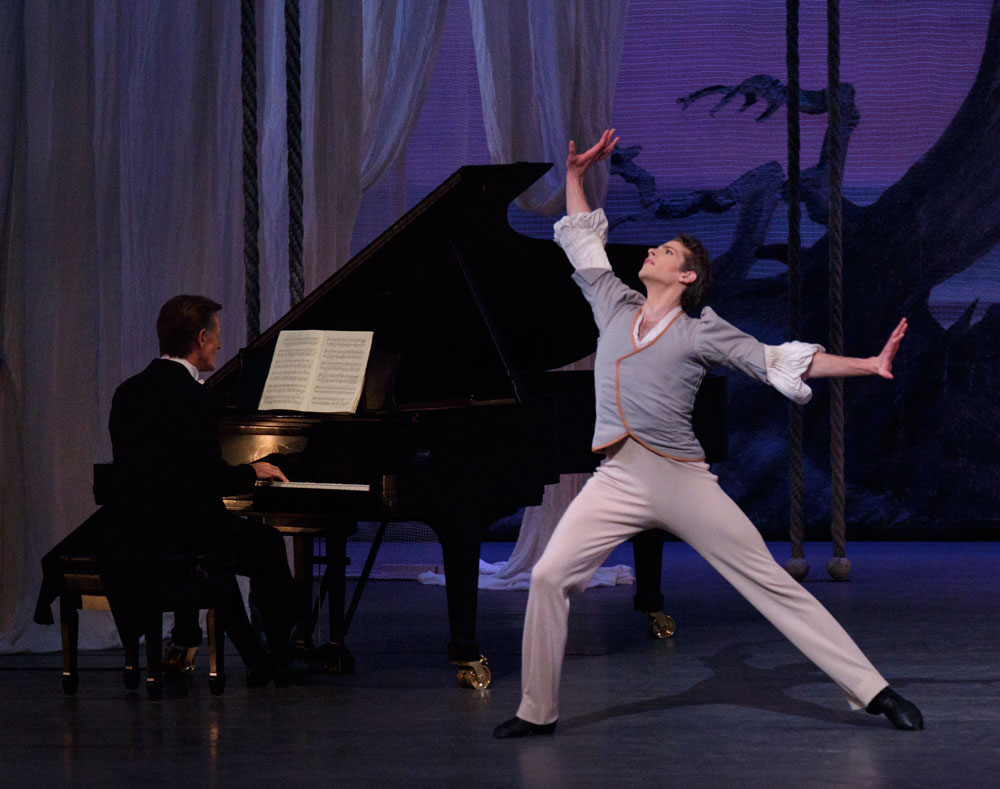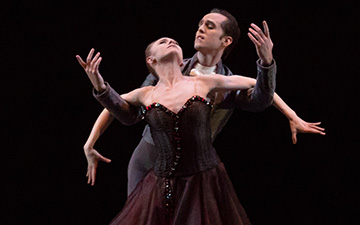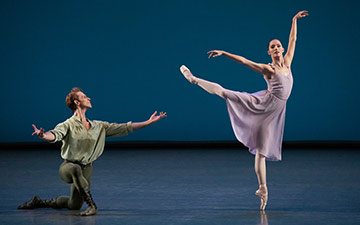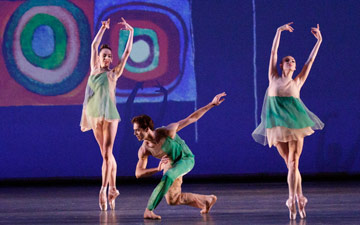
© Paul Kolnik. (Click image for larger version)
New York City Ballet
Chaconne, Interplay, After the Rain, Everywhere We Go
New York, David H. Koch Theater
11 October 2014
www.nycballet.com
Something Old, Something New
Beyond the excitement and flash – often quickly faded – of new works, the health of a company can be measured by the stream of new dancers stepping into roles created in a past that is always receding. Sometimes, as in the case of Balanchine’s Chaconne, a ballet is so indelibly stamped with the qualities of its original performers that it seems almost pointless to try to replace them. In 1976, Balanchine composed Chaconne for Suzanne Farrell and Peter Martins; the combination of Martins’ authority and Farrell’s remoteness and stylistic freedom – apparent even on video – imbued this delicate ballet with its particular aura. As Nancy Goldner writes in her invaluable More Balanchine Variations, “when I write about the power of a leg at a certain moment, I describe in part the power that Farrell gave to it.”
And yet, replace them the company must, again and again, or else the ballet will die. On Oct. 11, the lead dancers débuting in Chaconne were Sara Mearns and Russell Janzen. Janzen has emerged in recent seasons as a dancer of rare intensity and absorption. I missed his début in Balanchine’s Davidsbundlertänze last spring, described by Alastair Macaulay as “the finest account of this role to date,” high praise for a member of the corps stepping into one of his first major parts. But even in his relatively uncomplicated role of the poet in Balanchine’s Élégie – the opening section of Tchaikovsky Suite No. 3 – the power of his imagination and emotional intelligence were clear. One became immediately aware of the arrival of a person onstage, not just a technician. Janzen has spoken of the excitement of “giving yourself over to what’s about to happen” in a performance; in Chaconne, that feeling was palpable from the moment he and Mearns walked forward from the rear of the stage in an expansive arc, stepping slowly through the corps as in a dream, eyes downcast and then deliberately lifted above the horizon. (The opening of Chaconne, set to the “Dance of the Heavenly Spirits” from Gluck’s Orphée et Euridice, is set in a kind of cosmic place beyond time.)

© Paul Kolnik. (Click image for larger version)
The spell didn’t quite hold through to the end of the dreamlike duet, but the essence of it was there. Even though Mearns has gained in subtlety and control, there is an irrepressible drive in the way she executes the steps that sometimes overpowers the limpid choreography of Chaconne. This isn’t a criticism, really – this force is what makes her such a fascinating dancer. But the poetry of this duet lies elsewhere, in a kind of fateful acceptance that lends an immortal weightlessness to each movement. In the multiple floating lifts, with one leg pedaling through the air or pushing off the ground beneath her, the ballerina in Chaconne transcends gravity. The illusion is that she is propelling herself and her partner across the galaxies. With Mearns and Janzen, the illusion comes and goes. But this is only their first performance; check back in a season.
Later in the ballet, the two dancers share another duet, a musical conversation in the vein of the theme-and-variations from Balanchine’s Mozartiana. It begins with a formal minuet, anchored in a grand walking theme in which the dancers drag one foot, then the other, like elegantly prancing steeds. Then, to a gavotte, the two alternate in multiple entrées, at first addressing the audience, then each other. The footwork is brilliant and buoyant; Balanchine tailored it to Martins’ effortlessly elegant Danish petit allegro technique and to Farrell’s lilting musicality. The cornucopia of steps cascades forth without a pause for breath. And here, Mearns and Janzen come into their own. Mearns’ delivery is more muscular than Farrell’s; she replaces Farrell’s artlessness and freedom with a joyful sizzle. Halfway through, addressing her partner, her face breaks into a half-smile. In contrast, Janzen’s dancing has an unforced authority and weightedness that is well suited to the baroque courtliness of the dances. His footwork is also clear and crisp. More importantly, he looks relaxed. When the two finally come together, the wit of their give-and-take rises to an even higher level.

© Paul Kolnik. (Click image for larger version)
Such wit was sometimes lacking in the ensembles, which left a more pallid impression. The courtly dances, geometric formations, jester-like and troubadour numbers should be more incisive, less self-consciously pretty. In many ways, Chaconne – again, like Mozartiana – is a celebration of femininity and delicacy. But if it’s allowed to get too soft and gauzy around the edges, it starts to look merely decorative.
Chaconne was the opening work of a program that also included Jerome Robbins’ Interplay, Christopher Wheeldon’s After the Rain, and Justin Peck’s new ballet from last season, Everywhere We Go. Despite the sometimes irritating cuteness of Interplay – much hand-waving, “come on” gesturing, and clapping – one can’t help but be struck by the tightness of Robbins’ compositional craft. He creates a scenario – kids playing around – and builds on it, weaving the steps into clever musical structures (theme-and-variations, canon, call-and-response) that masquerade as games (hopscotch, Simon Says). The pas de deux – here danced by Lauren Lovette and Chase Finlay – is innocent but also sexy, sprinkled with those magical Robbins lifts that come out of nowhere. One cringes a little at seeing dancers in their twenties playing adolescents, but the truth is that they there’s nothing infantilizing about the technical feats Robbins asks of them; the playfulness hides a high level of difficulty. Joseph Gordon – rapidly proving himself a strong presence among the new generation of men – and Harrison Ball both made strong impressions.

© Paul Kolnik. (Click image for larger version)
What more is there to say about After the Rain, except that Wendy Whelan dances this pas de deux – made for her and Jock Soto in 2005 – with such simplicity and lack of ornamentation that it leaves her audience feeling as if it knew her most intimate thoughts. That she accomplishes this without a lick of melodrama is all the more impressive. In her pale pink leotard, legs and feet bare, she looks utterly exposed, no longer interested in hiding her imperfections, imperfections that are after all part of being human. (The pas de deux used to be danced in ballet slippers. This is the first time I’ve seen it danced barefoot; it adds to the feeling of plain-ness.) The pas de deux itself is almost step-free. Mostly it consists of a few tilts and bends this way and that, with the woman’s self-abnegating partner gently supporting, rolling, lifting and moving her body. The man (Craig Hall in this case) is reduced almost to an essence, the male lover. The audience experiences the pas de deux entirely from the woman’s point of view, Whelan’s point of view. Without fussiness, she projects an inner life – beset by some sadness, some lassitude – that is both complex and down-to-earth.
A second viewing of Peck’s Everwhere We Go reveals an ambitious, sprawling work, brimming with ideas and energy, but somewhat hampered by its score. Sufjan Stevens’ suite is dynamic and at times pulse-quickening, but also maddeningly unsubtle, both in its bombast and in its sentimentality. And because of this, it is at odds with the sophistication and facility that is one of Peck’s most compelling qualities.

© Paul Kolnik. (Click image for larger version)
The ballet begins well, with a striking duet for two men, or rather for a man and his shadow. This shadowing theme suffuses the rest of the ballet, particularly the complicated relationship between principals and corps. Peck constantly subverts the hierarchies of lead dancers and ensemble. Dancers melt in and out of larger formations; at times the shadow figures become the main event. Peck’s configurations for the ensemble are often asymmetrical, non-frontal, kaleidoscopic, but never less than clear. In this new cast, Ashly Isaacs takes on the role originally made for Tiler Peck and makes it her own, dancing with aplomb and bracing athleticism, particularly in a section that requires her to run in great loping strides, on pointe. (Isaacs, too, seems poised for bigger things.) In Robert Fairchild’s role, Adrian Danchig-Waring brings out a darker hue, like Orpheus leaving the underworld. Meanwhile, his Eurydice (Rebecca Krohn) is continually pulled back into the underworld. Teresa Reichlen’s role, gyrating through the multitudes, is enigmatic as ever. This loner motif seems to be a recurring one with Peck: he uses Anthony Huxley similarly in his new Belles Lettres. But it’s unclear what these outsiders are meant to represent. They lack a point of view.
Karl Jensen’s designs, translucent cut-out backdrops layered and illuminated by Brandon Stirling Baker in such a way that they become shifting geometrical landscapes, are a visual delight. The transition from one configuration to the next becomes a major compositional element of the work. The women’s costumes also seem to have improved since last season: the cut of the white leotards is more flattering, or maybe I’ve just gotten used to them. In any case, despite its occasionally manic feel and heavy-handed score, Everywhere We Go still impresses, and the company looks fantastic – and energized – in it.
With novice casts giving new life to old ballets and a resident choreographer channeling the dancers’ energies into dynamic new works, it’s hard not to get the impression that New York City Ballet is on a roll.

















You must be logged in to post a comment.